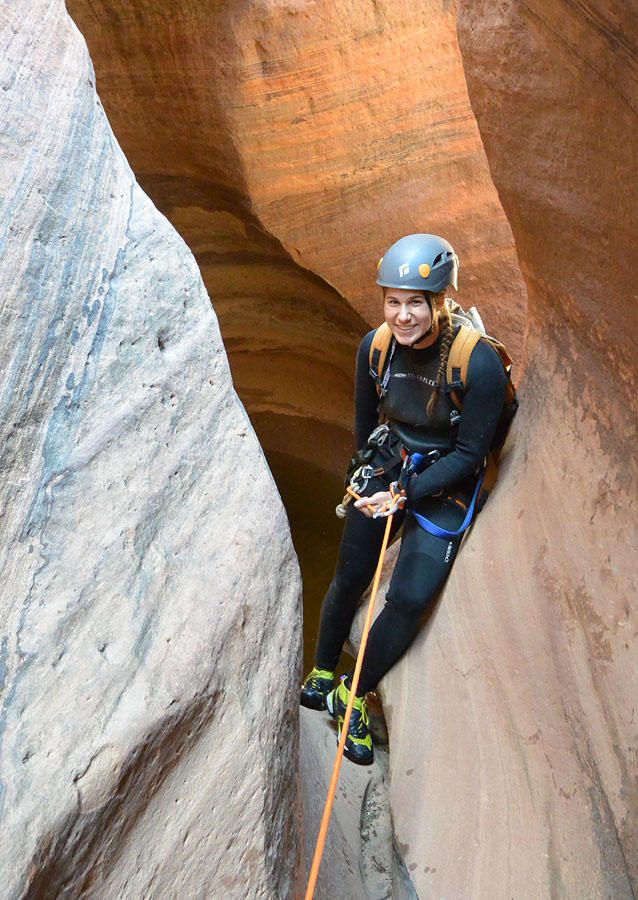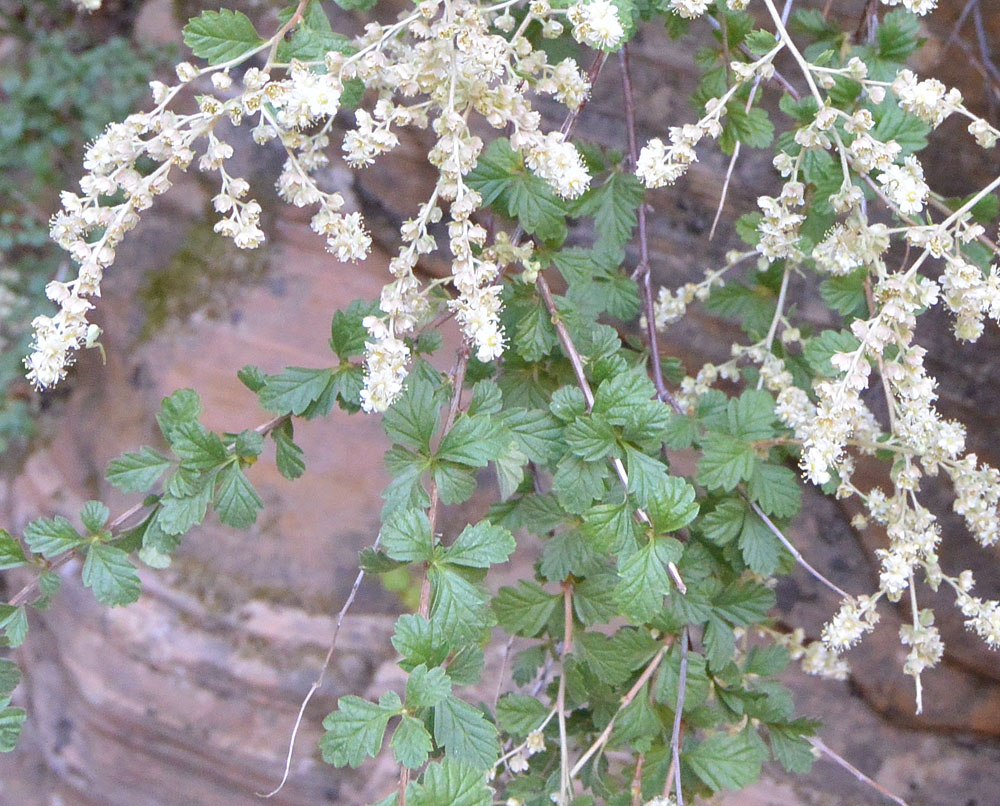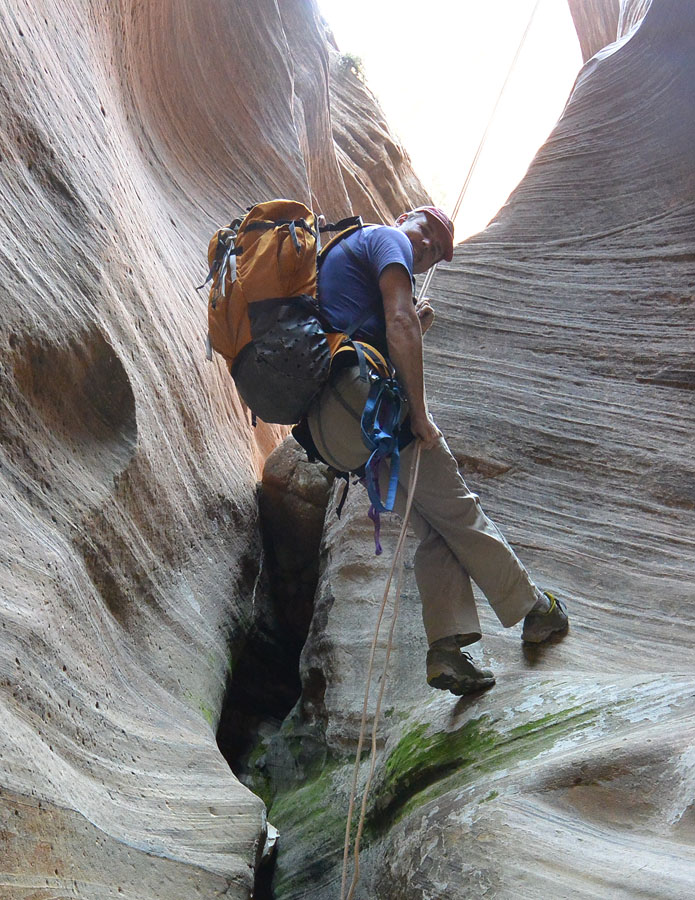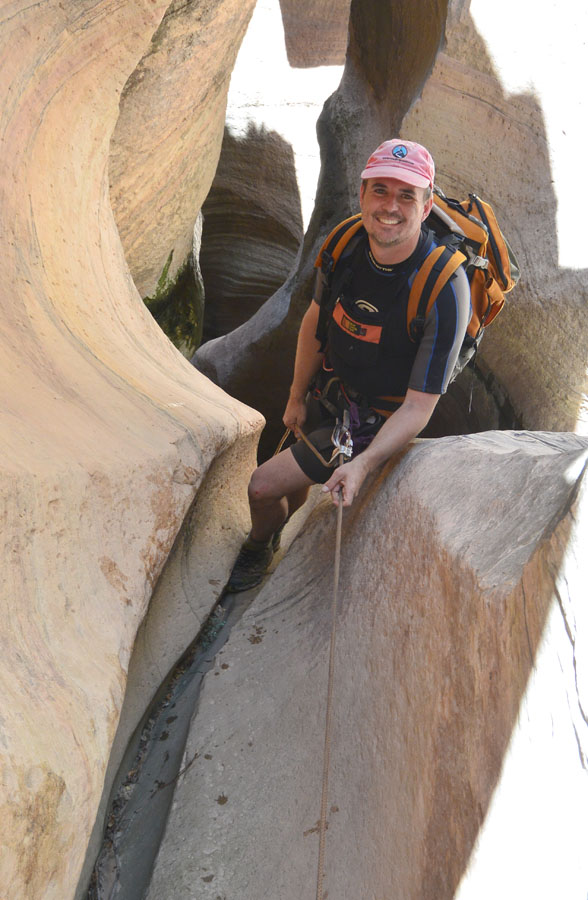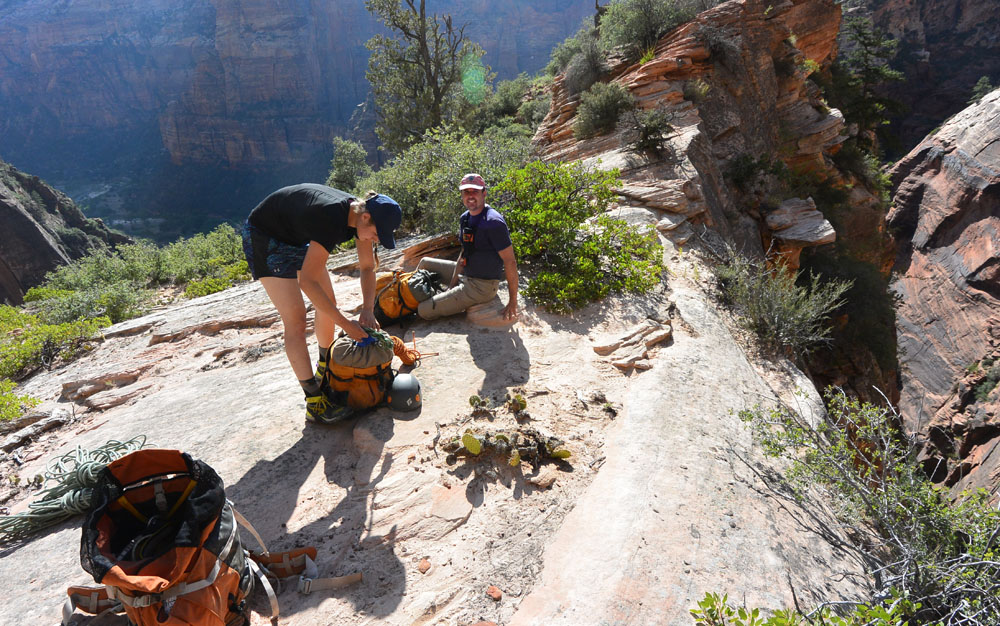Lower Echo, Descending and Ascending, Zion National Park, UT
Darn hot down here, it is, limiting choices to a few. But Lower Echo (Echo below the trail) is one that is deep and dark, with some water to cool off in. A short approach hike means, not so bad. But the penalty gets paid at the end—since the final rap out of the canyon is closed, one must fix ropes to exit the canyon. A while ago, I put in an anchor to improve the usability of the fixed rope—this would be my first time using this for the upper section of Lower Echo Companions for the day were Ryan Cornia from SLC, and Sue from Switzerland, an enthusiastic and athletic 'beginner' who had been doing a few canyons with ZAC folks. An early start is not required (bonus!), but carrying a lot of rope is (bleh!). Thankfully my companions are young and strong. We brought along enough rope to fix to the end of the canyon, if we had the time. We hopping aboard a shuttle bus and headed into the canyon. Crack of 9:55 found us crossing the bridge at Weeping Rock.
Up the East Rim Trail in the shade. Warm for sure, but not hot yet. As we came to the peninsula, we got a taste of sunshine and wow! So we sauntered on to the trail/canyon crossing, and slipped into the canyon to gear up at the top of the first rappel, and chill briefly in the shade. We grabbed some gear and two ropes and headed back along the trail to the peninsula, then down to the peninsula's col, where "we" would set the escape rope. "We" in this case being Ryan Cornia, volunteer!
Ryan is a top-notch canyoneer, AND volunteered to carry the heavy pack, AND volunteered to fix the ropes, which involves jugging up in the hot sun... so I will not slag him for not wearing a helmet, only noting that it seems incongruous with his otherwise excellent judgment. I threatened to replace his head on every shot with Sue's head... but ... just a threat.
Sue and I headed back to the first rap while Ryan did the work. I learned on this day that this section of Echo Canyon is used by many of the people on the trail for their bathroom activities. Additionally, people seem to be carrying wetwipes for this these days - far less biodegradable than regular toilet paper. Ryan pulled a rubber glove from his first aid kit; Sue and I picked up around 10 poo papers from places around the first rappel.
Then Ryan came back and we could work on canyoneering (11:45). There is a three bolt anchor for the first rappel, about 50 feet along the left rim of the canyon. If retrieving your rope, use this, as we did. If fixing ropes to jug out, it is better to fixe ropes down the watercourse, to avoid a steep jug. There is a small tree for an anchor. We climbed and rapped down the canyon. We soon came to something that looked wet, and chose to put on our wetsuits. Ryan slid down and leapt out seeking shallower water, which pretty much worked. (While an easy downslide, it would probably be wise to fix this if planning on coming up this way).
Shortly after was a rap into a lengthy pool. Yes, the water was cold. Yes, it was worth bringing the wetsuits. Soon after, we found a place in the sun, and had lunch. Next up is the 75' rap, the tallest in the upper section, into the dark, an icy pool awaiting below. A bit of a hard pull, but we got it down OK.
A few more raps and we got to our escape ropes at 2:00. Plenty of time to go all the way? You bet! We tied a rope onto the tail of the fixed rope (a 255' rope), and used this for the next drop (an almost-climbable slide) and for the next rappel, just beyond (a short one!). The next one was short too, and Sue, going first, found herself in a keeper pothole. She scrubbed a couple of spots clean of the immensely-slippery mud on the exit point, and did an impressive heelhook/mantle/bridge-out maneuver. I gave it a bit of a try, but soon accepted a sling handhold to slink my way out, as did Ryan.
Next up was the big rap in the lower canyon, about 70 feet. We cleared away a bunch of log and stick debris from the top of the rappel, and rapped on down. Two more short raps got us to the end of the canyon (3:00).
After a bit of lounging, it was time to head back. We dutifully headed back up - grunt, grunt, thrash thrash. Sue put Ryan and me to shame on the ascents, moving smoothly and swiftly up the rope. A case where youth and athleticism trumps old age and senility all the time. Wait, is that how that saying goes??? One problem that makes going up such an affair - the packs get heavier as you progress, as you add ropes. Fairly soon, we found ourselves at the exit rope, pulled out of the wetsuits, and figured out the best way to get ourselves and the luggage up to the top. A short steep jug gets one up to the bolt anchor re-belay ledge from my Jan 2015 effort. Above, 30 feet of steep wall lead to a low-angle slab; then 120 feet (or so) of easy jugging leads to the scorching hot sunshine atop the peninsula. We packed up and made it down to the bus stop by 6:30 or so.
A fine adventure. The Upper Lower Echo would be a nice adventure, of the long half-day variety. The extra time (1 hour down, 1/2 hour hang, 2 hours back up) to get to the end is not outrageous, but the effort of the upclimb back to the escape rope is substantial. Certainly the final jug out would be cake if one were not already tired from the previous jugging. Thanks to Sue and Ryan for indulging my desire to check this adventure out, and for being fun companions.
Beta: all the beta is in the several Latest Raves that cover this area. January 2015 and May 2009 Both descent and ascent would be slower with a larger group. Anchors are a mix of bolted and natural, so bring a bunch of webbing. Bring rubber gloves and good quality gallon size ziplocs. Be careful of unstable log debris. If you use the below-the-peninsula anchor, please leave it with NO webbing. The bolts are far apart, so use the rope and two biners to link the two bolts. Our rope for fixing was 255 feet... most likely a 200' rope would be suitable for fixing down to the b-t-p anchor, rigging the anchor and making it down into the canyon --- HOWEVER, there are logs there that allowed us to be 15 feet above the canyon floor. You MUST make sure the second fixed rope makes it down to where you can reach it from below, which requires rapping down 15 feet to the rollover. Ask Ryan what happens if you don't make sure.





